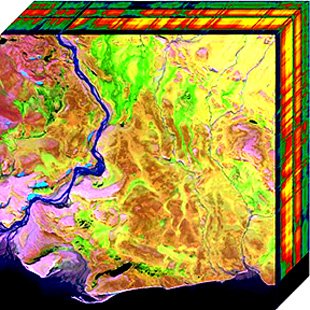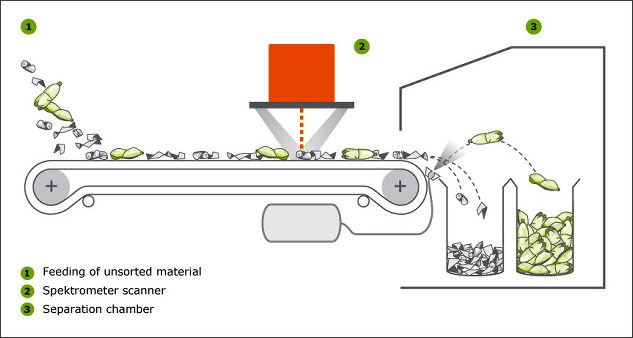High-Speed Hyperspectral Imaging facilitates Advanced Technologies like those for Plastic Recycling
Introduction
Modern society requests high standards from its industry: It should be efficient, economical, ecologically sustainable and at the same time offer the best possible working conditions for all concerned. Hence relentless working towards the fulfillment of these legit demands is implied.
One powerful way to tackle this goal is the intelligent utilization of novel sophisticated technologies. If used judiciously they can bring about substantial improvements in all four above mentioned criteria. With this article I would like to exemplify such an commendable implementation.
 Source: pixabay
Source: pixabayRecycling of Plastics
Plastics are state-of-the-art materials whose mechanical, electronic, chemical and optical properties can be precisely adjusted during their production. Because they are typically lightweight, resources are used efficiently. However, as bulk plastics are not biodegradable, efficient recycling must be installed to take the ecological aspect into account.
In principle, both material and energetical recycling are possible. In the first case, the plastic is reused as a material and in the second case it is used as an energy source. For both cases, it is essential to know the exact nature of the plastic, so whether it is PE, PP, PET, PVC, PU or any other.
Challenges of Recycling
Traditional plastic separation methods are based on physical properties, e.g. separation by density. However, such simple procedures are often not sufficient to achieve complete separation. Basically, this is only possible by a chemical-physical analysis of each piece of waste. An enormous workload!
A prime example for this are the following plastics, PVC and PET:
PVC - Polyvinylchloride: d = 1.10-1.61 g/mL
recycling methodlogy must consider high chlorine contentPET - Polyethylenterephthalate: d = 1.33-1.37 g/mL
material recycling is easily possible and advised
Due to the low costs of virgin polymers the utilization of very efficient, low cost techniques and processes is indicated for the recycling of plastics.
.jpg) Source: pixabay
Source: pixabayHyperspectral Imaging

Source: Wikipedia
Hyperspectral imaging (short: HSI) is a complex technique that generates multivariable images. This means that the two-dimensional pixel of normal images is transferred into a three-dimensional voxel. Today many different physical principles can be used to generate the third dimension of these images, e.g. near infrared or visible light spectra. One typical characteristic of these images is that they cover many wavelenghts, thus each voxel contains an almost continuous spectrum.
Using sophisticated methodology and relying on good calibration, these spectra can be evaluated very quickly and precisely. From the enormous data density that is generated, a lot of information can be extracted. Due to its considerable strengths, this technique is used in many fields:
- Agriculture: detection of grape variety and disease outbreaks
- Eye Care: detection of early retinopathy and other diseases
- Food Processing: identification of defects and foreign materials
- Mineralogy: rapid mapping of minerals in geological samples
- and for many more like Plastic Identification and Sorting!
The Technological Application
You now may wonder how exactly the previously presented technology is used. Letting aside all the complex evaluation techniques, this is relatively easy to understand. Advanced plastic sorting is performed by specialized equipment that consists of two major components:
- A sensing system that utilizes HSI technology to identify plastics.
- A device that usually uses a rapid stream of air to sort plastic objects.
The recognition of the exact type of plastic is based upon the NIR (near infrared) spectral components, which are contained in the HSI cube. The next figures show characteristic NIR spectra of various PET & PVC samples.
click to enlarge - data taken from Ref. [1]
PVC NIR Spectra: V...virigin - F...flakes - P...Pieces - R...Regenerated Flakes
click to enlarge - data taken from Ref. [1]
However, it must also be separated according to other criteria like additives. Otherwise, dyes would cause unwanted discoloration in the recycled PET product. Therefor the spectral VIS data (visible light spectrum) is utilized.
Finally, the whole process can be represented as follows:

Source: Van Dyk Recycling Solutions
Modern versions of these machines allow astonishing conveying and sorting speeds, which are up to 40 times higher than with previous sorting techniques. Furthermore, advanced learning software, sophisticated identification algorithms as well as high-precision air blast mechanics are used to easily achieve classification results of greater 90 %.
If you want to see the application of this process during the operation of a complete plastic sorting system, you should not miss this impressive video:
Conclusion
PET as a readily recyclable plastic shows continual growth in its' recycling rates in Europe. In 2016, this rate was just under 60 %. Also the recycling of other plastics is substantially facilitated by this technology.
With the technology presented here, the adequate waste management of plastics in general does not really have an economic barrier anymore, e.g. through old-fashioned time-consuming sorting processes. This shifts the core task to collecting and disposing, ie to a societal-logistical challenge.
Further videos can be found here:
- REDWAVE plastic sorting plant in Austria
- MSS CIRRUS Optical Sorter for HDPE and PET
mountain,phil28
References:
- M. Moroni, et. al. Sensors 2015, 15, pp. 2205-2227
- H. F. Grahn, P. Geladi (2007) Techniques and Applications of Hyperspectral Image Analysis. John Wiley & Sons, Ltd.
- PVC-Recycling-Technologien, vinylPLUS
- R. Humphreys (2017) More About Waste Plastic Sorting Technologies. Polymer Innovation Blog
- PET collection and recycling rates in Europe, petcore Europe, 2017
- MSS Sorting Technology, Homepage
- A Wikipedia Article
Very nice post (again^^).
Are those seperation techniques already fast enough to process high quantities of plastic garbage, or is just a minor part of the garbage sortable?
Thank you very much!
Yes, they are widespread and already perform a large majority of plastic sorting tasks at least in developed countries like those leading the plastic recycling rankings: Germany, France, Italy, Spain and UK
In some other videos, systems are shown at full workload - very impressive, but there the sorting process is hardly visible. :D
Feed them with bacteria XDD
https://www.newscientist.com/article/2080279-bacteria-found-to-eat-pet-plastics-could-help-do-the-recycling/
Btw i didnt expect there is still some meaningful use for IR stuff in this way XD
Ha! That's really cool but would be even nicer if they find bacteria which would efficiently transform other plastics into useable energy/platform chemicals. ;)
As said PET can readily be recycled. Only the mechanical stress during the recycling process leads to a gradual breakdown of the polymers, reducing the DP (Degree of Polymerization). This in turn affects mechanical properties and that's the reason why recycled PET is always mixed with virgin PET to get material of sufficient quality again. :)
Ha! You have to love IR. :P Don't mess with it. xD
I am not sure is the recycle process is economically realistic, as I was told that whats happening around me is that: Most plastic collected in the recycle bin are transferred to the
landfill again sadly
Where is 'around you'? :)
These sorting plants are quite common in many developed countries in Europe, but sadly not yet in every country or location in the world. There are still many places were awareness and initial investments in these plants has to be done.
As they run, they are economically, since they rarely need manual maintenance and allow the operators to sort waste into useful materials for re-use or for fueling CHP (Combined Heat & Power) plants.
Hong Kong /.
Everything is so expensive around here.
Just for your info (looking at the picture would be informative enough. The new is basically about putting back all the plastic bottles in recycle bin together with metal can and rubbish, and bring them all to landfill.........
http://hk.on.cc/hk/bkn/cnt/news/20160216/bkn-20160216050046786-0216_00822_001.html
Alot more saying that even with the gov continuous paying them, it is still not enough to cover all the cost for the recycling process.
(probably still need to wash bottles, and remove those plastic tags and stuff (?))
btw, Hong Kong is well known to be a tax "free" city (most of the things are tax free), but now we have to pay tax for plastic bags, and after implement for some years, people will bring their own bags and things get nicely
That's sad to hear. Let's hope that things change towards a more convenient and sustainable way of dealing with those latent material options like it is over here!
Let's all transport and spread the optimistic spirit necessary for progress. 😎
Very good post, this kind of information is what Steemit needs, I hope that the countries, the benefits of the activity so beneficial and important to help the planet, greetings :)
Thanks for reading and your comment! :-)